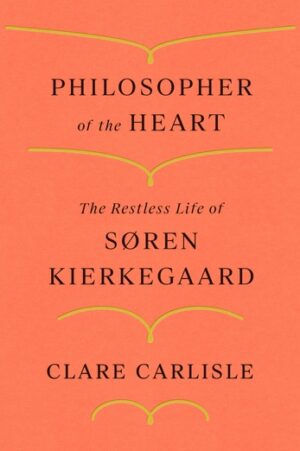Philosopher of the Heart
by Clare Carlisle
reviewed by Matt Hanson
Philosophers don’t tend to live very dramatic lives. Spending one’s time brooding over the human condition doesn’t make for an exciting story. Søren Kierkegaard, the subject of a recent book by English philosopher Clare Carlisle, Philosopher of the Heart: The Restless Life of Søren Kierkegaard, poses an interesting biographical challenge precisely because he was one of the greatest introverts of all time.
Kierkegaard preferred to commit his deepest thoughts to the pages he painstakingly self-published on expensive, tastefully chosen paper. They were often more respected or scoffed at than actually read by the public, especially in the bustling merchant city of Copenhagen. Despite Kierkegaard’s insularity, Carlisle accurately refers to him as a “philosopher of the heart.” She sensitively portrays a thinker whose most pressing philosophical reflections about anxiety, dread, despair, and the redemptive power of faith were informed by his lifelong ambivalence about breaking off the only romantic relationship of his life.
When he first met Regine Olsen, Kierkegaard had everything going for him. The last surviving son of a wealthy and spiritually haunted father, he had just written an acclaimed and still-compelling college thesis on how Socrates and Jesus used indirection and irony to challenge conventional thinking. A happy future seemed secured when he proposed to the lovely and intelligent Regine, who returned his feelings and empathized with his emotional turmoil, perhaps more than he ever realized.
Carlisle makes us see that this issue certainly worried Kierkegaard a great deal. As he confessed in one of his early diary entries: “I have just come back from a party where I was the life and soul … everyone laughed and admired me, but I went away—yes, that dash should be as long as the radii of the earth’s orbit———————————and wanted to shoot myself.” Despite his great promise, something was missing—a vital aspect of existence that demanded his full attention. Ultimately deciding that married life was incompatible with the philosopher’s quest, Kierkegaard broke off his engagement, causing a public scandal and a lifetime’s worth of tormented but fruitful reflection. “From Regine,” Carlisle writes, “he learned that no philosophical system, no merely intellectual approach to life, helps a human being to live in the world, to make decisions, to become himself.” Carlisle understands that, for Kierkegaard, conflict isn’t just a philosophical problem—it’s a daily battle. The clash between metaphysical freedom and everyday certainty was at the core of his voluminous writing. The possibility of living normally, with the everyday pleasures and pains of work, family, and a social life, was both too much and too little for him.
Philosopher of the Heart isn’t a cheat sheet for Kierkegaard’s theories. Instead, we have an evocative, novelistic portrait of what Kierkegaard’s life was like. Each encounter with Regine in the street, even years after the breakup, merits careful description. In their very last interaction,
[Regine] walked purposefully towards him and passed him close enough to quietly say “God bless you—may all go well with you.” At the sound of Regine’s voice, unheard for fourteen years, he stopped, almost took a step backwards, then greeted her before she hurried away. Thus in a moment, a glance of an eye, their long silence was broken. Later that day, Regine and her husband set sail … Kierkegaard would never see her again.
The scene so deftly sketched by Carlisle is tragicomic—remember, this awkward moment occurred a full fourteen years after their initial breakup. His “anchor in the world” was lost forever, even though that anchor hadn’t interacted with him in a very long time.
Carlisle sympathizes with Kierkegaard’s zealous commitment to intellectual and spiritual life. Any biographer would pretty much have to appreciate someone who is willing to let himself be grandiosely neurotic. The book speaks to readers whether they are familiar with Kierkegaard or not, since it doesn’t moralize or over-explain its subject’s life choices but instead presents him in all his flawed, angst-ridden, incorrigible humanity. As abstract as Kierkegaard’s writing can be, it’s clear that none of his precious thinking had as much impact on his philosophy as his emotional life. That kind of vulnerability is rare in philosophy. Kierkegaard never forgot the world outside his study even when he chose to sequester himself from it. Carlisle respects her subject’s intellectual accomplishments while acknowledging that even his remarkable literary output “did not express everything he was.”
For her part, Regine Olsen ended up marrying and raising a family and living an apparently pleasant and ordinary existence. At the end of her life, she let it be known that she harbored no ill will towards her ex-fiancé. On his deathbed, Kierkegaard specified in his will that his entire remaining estate be left to Regine, including the beautifully cut engagement ring he’d kept all those years, “exactly as if I had been married to her.” One of Kierkegaard’s famed maxims partially explains his own romantic crisis: “life must be understood backward. But … it must be lived forward.” Many sleepless nights went into that jewel of insight; Carlisle’s intimate study suggests that perhaps they were worth it after all.
Published on January 5, 2021

